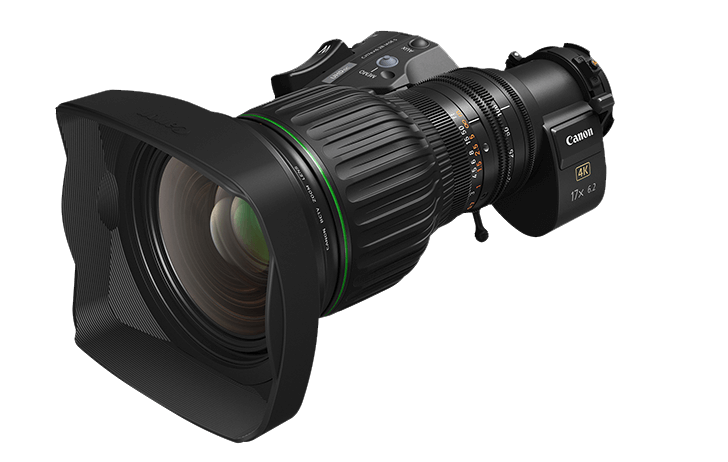The New Lens Features a 17x Zoom, Built-In 2x Extender, Cleverly Designed Lens Barrel and Coating to Help Reduce Ghosting and Flaring
MELVILLE, NY, April 7, 2021– Designed to provide both stunning HDR imagery as well as beautiful 4K, Canon U.S.A., Inc., a leader in digital imaging solutions, is introducing a new addition to its cost-effective UHDgc series of portable 4K broadcast zoom lenses — the CJ17ex6.2B. This lens supports 4K UHD quality optical performance and provides operators with a compact, lightweight, and highly portable form factor for easy integration into Houses of Worship, ENG, and commercial environments. With the addition of this lens, Canon further expands its lineup of 4K broadcast lenses, now at an industry-leadingi 18 models.
The CJ17ex6.2B features a wide-angle focal length of 6.2 mm and a 17x zoom ratio that brings the telephoto focal length up to 106 mm. The lens is also equipped with a built-in 2x extender that enables users to quickly double the focal length up to 212 mm while maintaining amazing image quality and fine details. The lens utilizes UD (Ultra-low Dispersion) lens elements, optimally arranged in a Canon proprietary optical configuration, providing superb color reproduction to the image's peripheral areas by enabling the suppression of potential chromatic aberrations such as color bleeding and fringing. Special lens coatings on all elements combine with a number of optomechanical strategies on the interior of the lens barrel to help reduce ghosting and flaring. Like all Canon 4K lenses, the CJ17ex6.2B comes standard with a drive unit that contains 16-bit absolute value encoders for smooth cooperation with CG environments, as well as three 20-pin connectors for easy integration into virtual and robotic systems. In addition, the lens supports HDR and WCG compatible color gradation, producing images rich with vivid colors and details.
The CJ17ex6.2B lens is easy to maneuver and shoulder, with its compact and lightweight design, weighing approximately 4.78 pounds and measuring approximately 6.49 inches (w) x 4.31 inches (h) x 9.46 inches (l) in size. The lens itself is designed with optimally located handgrips to help minimize operator fatigue when shoulder-mount recording.
Availability
The CJ17ex6.2B 4K UHD portable zoom broadcast lens is scheduled to be available in June 2021*. For more information, please visit, usa.canon.com/broadcast.


I do not work in TV but I could not find info about a camera with a 2/3" sensor with an EF mount.
I am also surprised to see the sensor listed as 2/3" instead of 1/1.5".
The standard seems to be to list sensor size by crop for video camera sensors less than 1".
As far as the model number, it makes sense when you know how their naming convention works(Fujinon is similar, but just with different letters). The easiest part is the number: 17 is zoom ration and 6.2 is the widest focal length (17ex6.2)
C: denoting it’s designed for UHD/4K cameras (H for HD and no prefix for SD)
J: 2/3” cameras (H for 1/2”)(there is no HH for 1/2” HD lens, tho. It’s KH)
17ex: Zoom ration
6.2: Widest focal length
B: B4 mount cameras (B3 used to be another mount, but was never that popular and you never see it today)
There are additional suffixes denoting built-in extenders, servos for zoom, focus, iris; and additional features/functions. There are also other permutations of the prefix lettering system to denote the “pro video”(vs. “broadcast”) line of lenses as well as ENG/handheld/portable vs Studio/Box lenses.
Good to know.
Thanks!
I should have really said holdover instead of throwback, as it was probably just continuously used before, during and after the transition from tubes to chips. But that was a little before my time in the industry(mid-ish 90's). By the time I started shooting, then, every camera I laid my hands on was CCD. Until large sensor cameras, with CMOS sensors, started to really come into play.